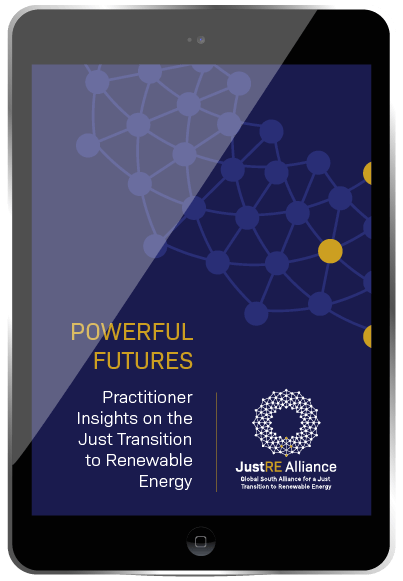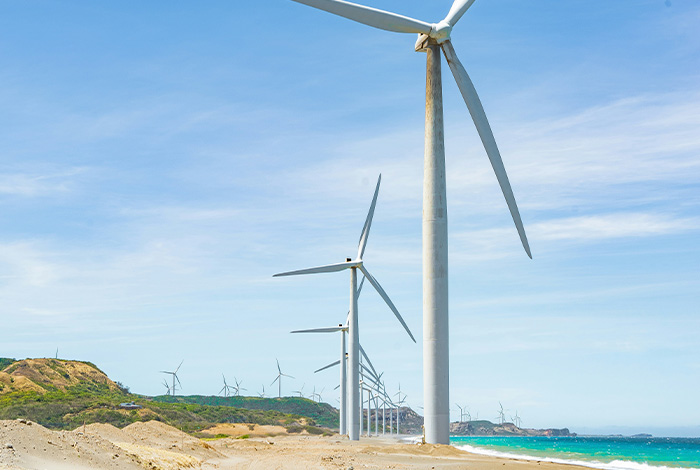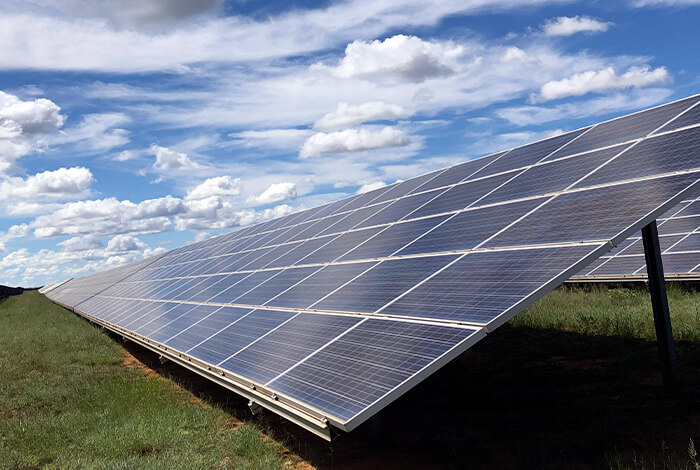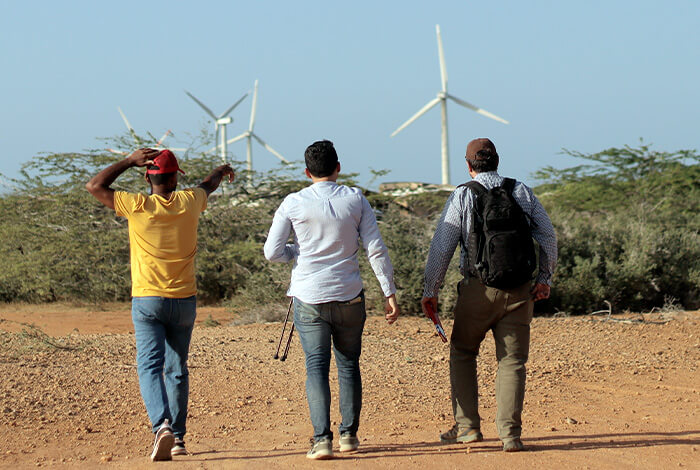The development of RE significantly impacts people’s rights and access to multiple natural resources. In this chapter, we discuss the challenges associated with land and water management arising from the deployment of utility-scale RE. We also explore emerging responses and cases where these have been applied and share some learnings from JustRE’s experience.
Context
Onshore solar and wind projects require significant land. Unfortunately, competition over land is intensifying as renewable energy projects increase. Wind projects typically require 0.2 to 0.8 hectares per megawatt (MW), while solar projects typically require 1.2 to 2 hectares[1]Balance Power, 2023, Understanding The Land Requirements For Renewable Energy per megawatt (MW). The world’s largest solar project, currently being built in India, will cover 726 square kilometres, an area the size of Singapore.[2]ABC Asia, 2024, In the salt deserts bordering Pakistan, India builds its largest renewable energy project Yet RE is still sometimes understood to be less land-intensive than the current fossil fuel-dominated energy systems (especially when considering distributed RE and energy efficiency).[3]Frontier Group, 2022, How much land will a renewable energy system use? At the same time, wind and solar projects can allow for multiple uses within the same land area, such as agricultural activities that can be co-located with the energy infrastructure.
Land acquisition processes are a common driver of conflict between developers, governments, and local communities, including Indigenous groups.[4]Business & Human Rights Resource Center, 2023, Renewable Energy & Human Rights Benchmark 2023 The challenge is particularly acute when land rights are customary or when identifying legitimate tenure rights holders is complex. This is often the case in countries in the Global South, where multiple land tenure systems, formal and informal, may exist in parallel and where reform processes and government records relating to land use and rights are often incomplete.
Existing inequalities within communities can be exacerbated by land acquisition processes. For example, in India, RE companies frequently engage in transactions with formal land owners, negotiating financial compensation for land to be allocated for project use. This can create greater economic and social disparities between landowners, who receive funds and status, and the landless, who lose access-and-use rights, making them more vulnerable. These compensation practices often exclude women from consultations and agreements, even though they play a substantial role in agricultural economies.[5]Responsible Energy Initiative, 2024, Renewable Energy to Responsible Energy: A Call to Action
Solar projects also need a significant amount of water for cleaning. Competition for water use is consequently heightened, especially in water-stressed areas. Using chemicals on renewable energy project sites, such as dust suppressants and dielectric fluids, can contaminate groundwater.[6]Responsible Energy Initiative, 2024, Renewable Energy to Responsible Energy: A Call to Action
Emerging Good Practice
Several good practices for inclusive land and water resource management are emerging in the context of RE development. There is much to learn from other infrastructure sectors and social practitioners’ experience. Below, we share some highlights of good practice to support others looking for possible courses of action in land and water.
Establishing robust environmental and social impact frameworks is essential for effective land and water management.[7]World Bank Group, 2017, Environmental and Social Framework ESIAs analyse a planned project’s positive and negative consequences based on a deep contextual understanding and community engagement. These instruments provide an updated and comprehensive information inventory from which to develop a set of actions that maximise the project’s positive impacts and minimise the negative ones.[8]International Association of Impact Assessment, Social Impact Assessment [Accessed in June 2024]
ESIAs represent international good practice, as exemplified by the requirements of international financial institutions such as the International Finance Corporation (IFC)[9]International Finance Corporation, Environmental and Social Categorization [Accessed in June 2024]
and the World Bank. These organisations provide extensive standards and guidelines to effectively conduct ESIAs, which can be adopted and adapted by countries and corporations to fit their particular needs.
Some countries integrate social and environmental assessments into a single process, while others conduct them separately. Integrated assessments can provide a more holistic view of a project’s impacts, considering the interplay between social, livelihood, and environmental factors. Sectoral planning tools that consider the long-term, cumulative social, economic, and environmental impacts of multiple RE projects in the same general area are also essential. The preparation of Strategic Environmental Assessments (SEAs) can serve as a basis for a regional planning approach that takes account of the combined effects of different industry players using sites close to each other.
Site selection for utility-scale RE projects requires careful consideration of the potential impacts on land and water resources. It is generally accepted that to minimise impacts, projects should prioritise land that is barren, uncultivable, or culturally and ecologically non-significant. However, no universal definitions for identifying such lands exist, and sometimes, land is officially classified as “wasteland” when used based on customary arrangements.
Community engagement and dialogue are essential for responsible site selection. Integrating the local knowledge of communities can highlight appropriate approaches for safeguarding traditional land practices and cultural amenities, ensure locally led development initiatives, and mitigate adverse RE project impacts on the community. Using tools incorporating technical and social indicators can help identify the most appropriate site for a project. An example is the SiteRight Tool[10]The Nature Conservancy Centre, The SiteRight Tool [Accessed in June 2024] in India. This spatial mapping instrument considers factors like solar irradiance, wind patterns, and ecological and socio cultural factors such as species habitats and ancestral or spiritual locations. However, it is crucial to note that these tools have limitations, such as relying on official data that may not reflect community understanding of resource use patterns. They are not substitutes for community engagement (see Chapter Effective Community Engagement).
Respecting the land rights of legitimate tenure holders is essential, including where land and property rights are customary, collective, or not formally recorded. Land ownership varies in each country, but adherence to international standards such as the Free, Prior, and Informed Consent (FPIC) should be applied when customary land — individual or collective — is considered for renewable energy installations. FPIC ensures that the rights and interests of all land users are respected and protected (for instance, Forest Rights Act 2006[11]Ministry of Tribal Affairs, 2006, The Forest Rights Act (FRA), 2006 and LARR Act 2013[12]Parliament of India, 2013, Right to Fair Compensation and Transparency in Land Acquisition, Rehabilitation and Resettlement Act, 2013
in India). One example of an international framework for FPIC is the International Labour Organisation (ILO) 169 convention,[13]International Labour Organisation, 1989, Indigenous and Tribal Peoples Convention, 1989 (No. 169) which provides a consensus-building framework through consultation on Indigenous and Tribal lands.
Establishing an Indigenous consultation framework is an enabling factor for community engagement, fair benefit sharing, fair resource management, and inequality reduction. This can be achieved by creating a national legal framework and principles, guidelines, and procedures for its implementation.
Article 32, par. 2, of the United Nations Declaration on the Rights of Indigenous Peoples, provides that states must consult with the Indigenous Peoples in good faith to obtain their FPIC before approving any project affecting their lands or territories and other resources. Article 32 describes the FPIC process, which, if properly implemented, affords safeguards for Indigenous Peoples.
Establishing a clear national legal framework for FPIC helps build trust among all parties involved. Properly established consultation mechanisms and protocols can help address the root causes of conflicts and prevent new ones from arising. A prior and informed engagement with communities can also create the conditions for more equitable benefit sharing and ensure tangible benefits for the communities.[14]International Labour Organisation ILO, 2022, Just Transition Policy Brief: Indigenous Peoples and a Just Transition for All
Several countries have integrated FPIC into national legislation. For instance, in Mexico, the consultation process is established by law in the energy sector. In Colombia, the criteria and procedures for FPIC have been described in “Directivas presidenciales” (executive orders), decrees and Constitutional Court rulings without a statutory law. However, in both cases, stakeholders have criticised the lack of transparency, inadequate timing of engagement, coordination, and respect for local processes. Despite these challenges, having the framework and the protocol is important as they lay the foundation for improvement and ensure that Indigenous communities have a voice on legislative and administrative measures, projects, or activities (private or public) that take place in their territories as a way to protect their cultural, social and economic integrity.
Expropriation is defined as the “governmental seizure of property or a change to existing private property rights, usually for public benefit”.[15]Cornell Law School Legal Information Institute, Expropriation [Accessed in June 2024]
Acquiring land for RE projects through expropriation is not recommended since it causes significant adverse effects, including social conflicts and community disintegration. On the other hand, acquiring private land through a negotiated settlement between willing buyers and sellers is a more common and recommended approach. Compensation value should include the effect of dispossession on mental health, social fabric, and personal and community identity, as well as resources for capacity building such as financial literacy and management. Also, resettlement and rehabilitation plans must be co-designed with the affected community.[16]Indian Development Review, 2024, Ground realities: Making land work for renewable energy
However, this negotiated land acquisition can be challenging and costly for developers. For instance, the LARR Act in India stipulates compensation for private rural land that is much higher than the current market value.[17]Business & Human Rights Resource Center, 2023, Renewable Energy & Human Rights Benchmark 2023
For RE projects, land leasing arrangements tend to be a more favourable option for landowners than outright sale. Leasing terms are agreed between parties, ideally including regular payments for a period aligned with the project lifetime. Lease fees can be adjusted over the project timeframe to account for inflation. Land valuation should be context-specific and conducted by an independent expert. Landesa’s experience in Southeast Asia suggests that for less productive land, the minimum annual leasing rate should be between 1/15th to 1/10th of market value to be attractive. The market value of land is usually the result of recent transactions in the area and takes into account the type of land. In some countries, the value of agricultural land can be found in registers. One practice for extensive land holdings is to lease part of the land and retain the rest for agricultural purposes to ensure food security. This approach works particularly well for landowners of less productive large holdings in arid zones where crop failure is highly risky.
Solar and wind projects can allow shared land uses to address the competition for land and maintain or even strengthen local livelihoods. Agrivoltaics — a crop-growing system under solar panels — is an emerging field. Animal grazing on solar and wind project sites can maintain vegetation and reduce maintenance costs. An assessment should determine the most suitable shared land use design, considering local climate, soil conditions, crop types, and community needs. This ensures that the chosen approach maximises land use efficiency and local benefits.
The planning process for solar energy projects requires a water availability assessment for panel cleaning and any proposed onsite agricultural activities. Landscape and watershed-based ESIA that consider water demand and supply over the project’s lifecycle are essential for effective water management. Practices such as community water budgeting and stewardship[20]WOTR, Water Stewardship and Water Budgeting [Accessed in June 2024]
help ensure that water use is planned and prioritised holistically and over time so that the site does not compete with other uses.
A range of technologies are being deployed to make water use more efficient, from waterless cleaning solutions involving magnets or electrostatic repulsion,[21]MIT, 2022, How to clean solar panels without water to robots that use limited amounts of water.[21]Ecoppia, About Ecoppia [Accessed in June 2024]
While automation can be more efficient, fewer (if any) manual cleaning roles are required on-site, negatively impacting job creation potential.
Relevant Stakeholder Insights
Below, we share some key considerations when working with the private sector, policymakers, and communities to carry out responsible land and water management.
Future glimpse
Young Lorenzo remembers his grandmother’s stories about the day in 2025 when they lost access to their ancestral land. Thousands of blue-glass solar panels and wires were erected in the fields, threatening to splinter the community by erasing the glue that held the community together: their land.
Many years later, the painful memories of that day, captured and frequently retold in local lore, still inspire him to do his daily work with the renewable energy company. It is difficult for him to imagine such an injustice happening now. Thankfully, today, nobody would even contemplate simply fencing people out.
The developers are entwined with the local communities — economically and socially — thanks to the government’s law on designing for the context. Each morning, he walks through the solar farm to the sacred offering place, nodding at others as he goes and trying to avoid the temptation to pluck some of the arugula and spinach leaves from under the solar arrays.
As he crosses the low fencing into the solar farm, he laughs at the sight of a farmer chasing the goats away from the fresh produce waiting to be picked up for market. He feels comforted by thinking that the farmers’ land and livelihood are protected by the transparent longterm leasing agreement.
- Business & Human Rights Resource Center, 2023, Renewable Energy & Human Rights Benchmark 2023
- Business & Human Rights Resource Center, Shared prosperity models & Indigenous leadership for a just transition [Accessed in June 2024]
- Business & Human Rights Resource Center, 2023, Learning from success in renewable energy: Indigenous leadership & shared prosperity
- Business & Human Rights Resource Center, 2024, A just transition for all: Key tools for a fast & fair shift to renewable energy in Latin America
- Business & Human Rights Resource Center, 2023, Fast and fair: Achieving a just energy transition in Africa
- Accountability Framework Initiative, 2019, Operational Guidance on Free, Prior and Informed Consent
- Forum for the Future, Responsible Energy Initiative India [Accessed in June 2024]
- Forum for the Future, Responsible Energy Initiative Philippines [Accessed in June 2024]
- [1] Balance Power, 2023, Understanding The Land Requirements For Renewable Energy
- [2] ABC Asia, 2024, In the salt deserts bordering Pakistan, India builds its largest renewable energy project
- [3] Frontier Group, 2022, How much land will a renewable energy system use?
- [4] [17] Business & Human Rights Resource Center, 2023, Renewable Energy & Human Rights Benchmark 2023
- [5] [6] [19] Responsible Energy Initiative, 2024, Renewable Energy to Responsible Energy: A Call to Action
- [7] World Bank Group, 2017, Environmental and Social Framework
- [8] International Association of Impact Assessment, Social Impact Assessment [Accessed in June 2024]
- [9] International Finance Corporation, Environmental and Social Categorization [Accessed in June 2024]
- [10] The Nature Conservancy Centre, The SiteRight Tool [Accessed in June 2024]
- [11] Ministry of Tribal Affairs, 2006, The Forest Rights Act (FRA), 2006
- [12] Parliament of India, 2013, Right to Fair Compensation and Transparency in Land Acquisition, Rehabilitation and Resettlement Act, 2013
- [13] International Labour Organisation, 1989, Indigenous and Tribal Peoples Convention, 1989 (No. 169)
- [14] International Labour Organisation ILO, 2022, Just Transition Policy Brief: Indigenous Peoples and a Just Transition for All
- [15] Cornell Law School Legal Information Institute, Expropriation [Accessed in June 2024]
- [16] Indian Development Review, 2024, Ground realities: Making land work for renewable energy
- [18] World Resources Institute, 2021, India: A Large-scale Solar Park on Drought-prone Agricultural Land
- [20] WOTR, Water Stewardship and Water Budgeting [Accessed in June 2024]
- [21] MIT, 2022, How to clean solar panels without water
- [22] Ecoppia, About Ecoppia [Accessed in June 2024]




